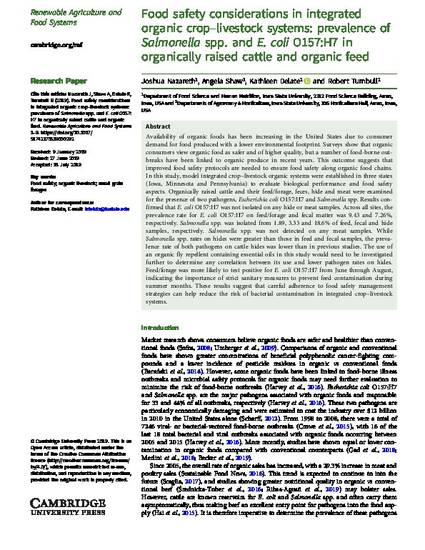
Availability of organic foods has been increasing in the United States due to consumer demand for food produced with a lower environmental footprint. Surveys show that organic consumers view organic food as safer and of higher quality, but a number of food-borne outbreaks have been linked to organic produce in recent years. This outcome suggests that improved food safety protocols are needed to ensure food safety along organic food chains. In this study, model integrated crop–livestock organic systems were established in three states (Iowa, Minnesota and Pennsylvania) to evaluate biological performance and food safety aspects. Organically raised cattle and their feed/forage, feces, hide and meat were examined for the presence of two pathogens, Escherichia coli O157:H7 and Salmonella spp. Results confirmed that E. coli O157:H7 was not isolated on any hide or meat samples. Across all sites, the prevalence rate for E. coli O157:H7 on feed/forage and fecal matter was 9.43 and 7.26%, respectively. Salmonella spp. was isolated from 1.89, 3.33 and 18.6% of feed, fecal and hide samples, respectively. Salmonella spp. was not detected on any meat samples. While Salmonella spp. rates on hides were greater than those in feed and fecal samples, the prevalence rate of both pathogens on cattle hides was lower than in previous studies. The use of an organic fly repellent containing essential oils in this study would need to be investigated further to determine any correlation between its use and lower pathogen rates on hides. Feed/forage was more likely to test positive for E. coli O157:H7 from June through August, indicating the importance of strict sanitary measures to prevent feed contamination during summer months. These results suggest that careful adherence to food safety management strategies can help reduce the risk of bacterial contamination in integrated crop–livestock systems.
Available at: http://works.bepress.com/angela_shaw/30/

This article is published as Nazareth, J.*, Shaw, A., Delate, K., and R. Turnbull. 2019. Food safety considerations in integrated organic crop-livestock systems: Prevalence of Salmonella spp., and E.coli O157:H7 in organically raised cattle and organic feed. Renewable Agriculture and Food Systems; doi: 10.1017/S1742170519000292.